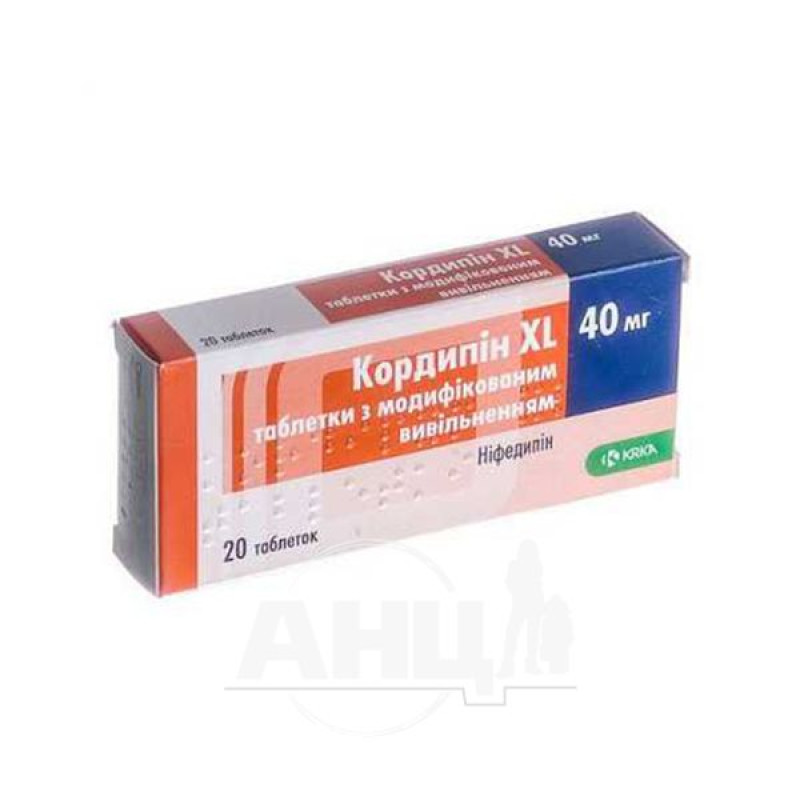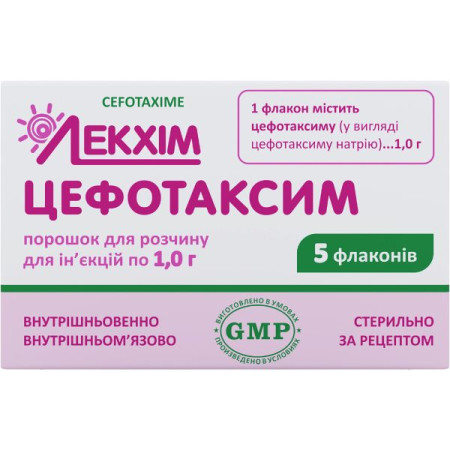Cordypin XL modified-release tablets 40 mg No. 20

Pharmacological properties
Pharmacodynamics. nifedipine inhibits the influx of calcium ions into cardiomyocytes and smooth muscle cells of the coronary and peripheral arteries. dilates the coronary arteries, thereby increasing the inflow of oxygen. reduces the need for myocardial oxygen by reducing myocardial contractility and heart function, as well as by reducing afterload. normalization of elevated blood pressure occurs due to the expansion of systemic arteries and arterioles and a decrease in peripheral resistance.
Pharmacokinetics.
Cordipin XL (modified-release tablets). Nifedipine is almost completely absorbed after 5-10 minutes. The maximum serum concentration is reached 5 ± 2.7 hours after administration.
94-99% of nifedipine is bound to plasma proteins. Protein binding is reduced in patients with renal failure, cirrhosis, ischemic heart disease, and patients on hemodialysis. It is completely metabolized in the liver by cytochrome P450, the CYP3A4 isoenzyme, with the appearance of inactive metabolites. 80% of nifedipine and its metabolites are excreted in the urine, and the rest in the feces. The half-life is 14.9 (± 6.0) hours, it may be slightly prolonged in patients with renal failure.
Cordipin retard. (Extended-release tablets). Nifedipine is rapidly and completely absorbed in the gastrointestinal tract. In serum, it is determined after 10 minutes, the maximum concentration is reached after 30-60 minutes after administration.
From retard tablets, nifedipine is released more slowly and reaches maximum serum concentration 2-4 hours after administration, and the effect lasts from 10 to 12 hours.
Nifedipine binds to serum proteins. It is metabolized in the liver to inactive metabolites. 80% of nifedipine and its metabolites are excreted by the kidneys. Renal failure, hemodialysis and peritoneal dialysis do not affect the kinetics of nifedipine.
Indication
Ag.
Angina pectoris is mainly vasospastic and chronic stable angina.
Application
The dose is set individually for each patient. The tablets can be taken during or after meals. The patient should be warned about the need to regularly take the tablet at the same time and not to increase the prescribed dose. If the patient forgets to take the tablet on time, the next dose should not be doubled.
Cordipin XL. The dose is set individually for each patient. Usually the initial and maintenance dose is 1 tablet per day; the maximum recommended dose is 2 tablets per day as a single dose. The dose is selected gradually, with an interval of 7-14 days. It is necessary to use the whole tablet, washing it down with a glass of water, before, during or after a meal.
Cordipin retard. The usual dose is 1 prolonged-release tablet 2 times a day. If necessary, the dose can be increased to 2 tablets 2 times a day. For patients with Prinzmetal's angina (vasospastic angina), the daily dose can be increased to 80 mg or a maximum of 120 mg per day.
Contraindication
Hypersensitivity to nifedipine or any component of the drug, hypersensitivity to other dihydropyridines; cardiogenic shock, severe aortic stenosis, porphyria, breastfeeding period - for Cordipin XL, in addition, acute period of myocardial infarction - for Cordipin retard.
Side effects
The most common side effects are dizziness, headache, fatigue, weakness, orthostatic hypotension, facial flushing (flushing of blood to the face), peripheral edema, gastrointestinal disorders (dry mouth, gum hypertrophy, nausea, heartburn, constipation, diarrhea), rapid or irregular heartbeat, palpitations, chest pain. The following side effects occur less frequently: muscle pain, muscle cramps, itching, hives, skin rashes.
Cardiovascular system: tachycardia, arterial hypotension, orthostatic hypotension, myocardial ischemia, conduction disorders.
Central nervous system: dizziness, headache, fatigue, paresthesia, tremor, depression, nervousness, sleep disorders, blurred vision, anxiety, ataxia.
From the gastrointestinal tract and liver: dry mouth, gingival hypertrophy, nausea, heartburn, belching, vomiting, intestinal colic, flatulence, constipation, diarrhea, allergic hepatitis, cholestasis, jaundice.
Respiratory system: angioedema, difficulty breathing through the nose (nasal congestion), shortness of breath, cough, nosebleeds, upper respiratory tract infections.
Skin: rash, itching, erythema, rarely - exfoliative dermatitis, erythema multiforme, Stevens-Johnson syndrome, toxic epidermal necrolysis, alopecia, photosensitivity.
From the urinary system: nocturia, increased diuresis, dysuria, hematuria.
From the side of the hematopoietic system: rarely - anemia, leukopenia, thrombocytopenia, aplastic anemia.
Other reactions: weight gain, gynecomastia, increased body temperature, in rare cases - a transient increase in serum glucose concentration.
Special instructions
Nifedipine should be used with caution in patients with a tendency to hypotension, severe mitral/aortic stenosis, malignant hypertension, hypovolemia, myocardial infarction, heart failure.
The simultaneous use of nifedipine and β-adrenergic blockers can sometimes lead to the development of heart failure.
At the beginning of treatment with nifedipine or when the dose is increased in patients with severe coronary artery disease, the course of coronary artery disease may worsen (with an increase in the frequency of angina attacks) due to activation of the sympathoadrenal system.
During treatment with nifedipine, it is necessary to limit the administration of large volumes of fluid, as this increases cardiac preload and increases the risk of pulmonary edema.
During nifedipine therapy, edema may occur (most often in the lower extremities), and the use of diuretics is effective.
Nifedipine may affect the values of some laboratory tests (increased alkaline phosphatase, AST, ALT, LDH, increased serum urea and creatinine concentrations, positive Coombs' test) without clinical manifestations, although cases of cholestasis and jaundice have been observed.
Use during pregnancy and breastfeeding. Nifedipine should only be used in pregnant women if the potential benefit to the mother outweighs the potential risk to the fetus. Breastfeeding women should not use this medication because nifedipine passes into breast milk.
Children: The safety and effectiveness of nifedipine in children have not been adequately studied, so this drug is not prescribed for this age group.
Effects on ability to drive and use machines. Nifedipine has no significant effect on the ability to drive and use machines. However, in susceptible patients, especially at the beginning of treatment or when taking alcohol, nifedipine may cause hypotension and dizziness and impair the ability to drive and use potentially dangerous machines. Until an appropriate individual response to treatment is determined, patients are advised not to drive or use machines.
Interactions
When using antihypertensive agents, β-adrenergic blockers, diuretics, nitroglycerin and prolonged-release isosorbide, the possibility of synergistic effects of nifedipine should be taken into account. The hypotensive effect of nifedipine is enhanced by the simultaneous use of tricyclic antidepressants.
Fentanyl may cause hypotension in patients treated with nifedipine. Nifedipine should be discontinued at least 36 hours before elective surgery with fentanyl anesthesia.
Concomitant use of nifedipine and cimetidine, ranitidine may lead to an increase in nifedipine serum concentration and an increase in the hypotensive effect of nifedipine.
In patients already taking cimetidine, nifedipine should be used with caution, with the dose increased very gradually.
The administration of nifedipine may lead to an increase in the serum concentration of carbamazepine and phenytoin.
Nifedipine may lead to a decrease in serum quinidine concentrations, while quinidine may increase the patient's sensitivity to the effects of nifedipine.
Nifedipine may potentiate the toxic effects of magnesium sulfate, leading to neuromuscular blockade. The simultaneous administration of nifedipine and magnesium sulfate is dangerous and may threaten the patient's life, therefore, the simultaneous use of these drugs is not recommended.
During the simultaneous administration of nifedipine and theophylline or digoxin, the concentration of theophylline or digoxin in the blood serum may increase.
The parallel administration of rifampicin and nifedipine is inappropriate, since due to the stimulation of liver enzyme activity by rifampicin and the acceleration of nifedipine metabolism, it is practically impossible to achieve an effective level of nifedipine concentration in the blood, which may lead to a weakening of the effects of the latter.
Concomitant treatment with nifedipine and itraconazole (possibly also with other azole antifungals, erythromycin and clarithromycin, which inhibit the CYP 3A4 isoenzyme) may lead to an increase in the concentration of nifedipine in the blood serum and an increase in its effect, as well as an increase in the frequency of side effects. If side effects of nifedipine occur, its dose should be reduced (if possible) or the use of the antifungal agent should be discontinued.
The concentration of nifedipine in the blood serum and its effect may also be increased by the simultaneous administration of the following drugs: cyclosporine, indinavir, ritonavir or saquinavir (inhibitors of the cytochrome CYP 3A4 isoenzyme activity). If side effects of nifedipine occur, its dose should be reduced.
During the simultaneous administration of tacrolimus and nifedipine, the concentration of tacrolimus in the blood serum may increase (it is metabolized with the participation of the CYP 3A4 isoenzyme).
In patients taking coumarin anticoagulants, an increase in prothrombin time has been observed after administration of nifedipine.
Nifedipine may alter the bronchial response to methacholine (if possible, treatment with nifedipine should be discontinued before performing the methacholine test).
Grapefruit juice may increase the serum concentration of nifedipine and enhance its hypotensive effect and the incidence of vasodilatory side effects.
The first manifestation of overdose is mainly hypotension. After taking a large number of tablets, shock, bradycardia or tachycardia, heart failure, nausea, vomiting, drowsiness, dizziness, confusion, lethargy, metabolic acidosis, coma and convulsions may also occur. These symptoms mainly occur within a few hours after taking the drug.
After taking a large number of tablets, it is necessary to take measures to remove the drug from the gastrointestinal tract (gastric lavage, taking activated charcoal and a laxative).
If hypotension occurs, the patient should be placed in a horizontal position with the lower extremities elevated. Intravenous administration of solutions and plasma substitutes is recommended. If these measures are ineffective, it is recommended to administer sympathomimetics (dopamine, dobutamine or noradrenaline) to increase blood pressure. During treatment, it is necessary to monitor cardiac function, respiration, circulating fluid volume and diuresis.
The cardiodepressive effect of nifedipine is inhibited by the administration of calcium in the form of a 10% solution of calcium gluconate or chloride (calcium chloride is not recommended for patients with acidosis). If the therapy is ineffective, glucagon can also be administered.
Atropine and orciprenaline are used for bradycardia; in severe cases, a temporary pacemaker is installed.
Hemodialysis, hemoperfusion, and plasmapheresis are ineffective measures for removing nifedipine from the body.
Storage conditions
In a place protected from light at a temperature not exceeding 25 °C.
There are no reviews for this product.
There are no reviews for this product, be the first to leave your review.
No questions about this product, be the first and ask your question.

